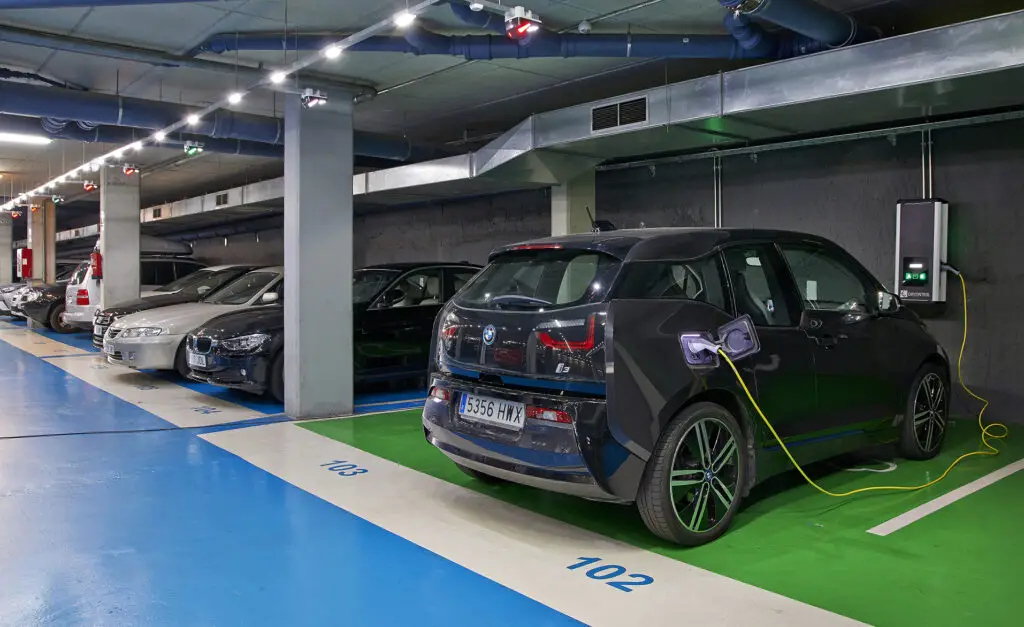Transportation is changing as a result of the electric vehicle (EV) revolution, which also presents new opportunities for innovation and company expansion.
Market analysts predict that 13% of new car sales in the U.S. in 2024 will be electric, reflecting a paradigm shift in how people drive and interact with their surroundings. This transformation opens doors for parking facility owners to not only adapt to evolving customer demands but also unlock lucrative revenue streams.
Today’s drivers are no longer searching for just a parking space—they seek an integrated solution where time at rest translates into usable energy for the road ahead. This concept creates a foundation for developing a profitable EV charging ecosystem, enabling parking lot operators to boost revenue per square foot while setting the stage for long-term success.
This guide delves into the myriad ways parking facilities can capitalize on the EV surge, transforming themselves into pivotal hubs of the future.
How Parking Facilities Benefit from EV Parking and Charging
In the United States, there are approximately 2 billion parking spaces serving fewer than 300 million vehicles. These spaces are dispersed across various categories:
- Commercial lots (e.g., Walmart): Typically free to customers.
- Parking garages: Often premium-priced in central urban locations.
- Specialized facilities: Serving venues like stadiums, airports, and hospitals.
- Residential spaces: Found in single-family homes or multi-unit dwellings.
While most drivers enjoy a broad selection of parking options, EV drivers are more selective. Their needs extend beyond a mere spot—they require charging infrastructure. By catering to this audience, parking operators can not only grow their market share but also reap significant rewards.
1. Attract and Retain Customers
Unlike traditional drivers, EV users proactively plan their parking decisions, often selecting locations based on their charging requirements. This dynamic offers a competitive edge to parking facilities equipped with EV charging stations, as these spaces become integral to an EV driver’s journey.
How EV Charging Attracts Customers:
- Mapped Presence: Facilities offering EV charging are highlighted on navigation apps, drawing attention from drivers who prioritize convenience.
- Positive Reviews: Exceptional service and reliable charging boost online reputation, amplifying business awareness.
- Customer Loyalty: Satisfied EV drivers are likely to return repeatedly, fostering predictable revenue streams.
Additionally, federal initiatives like tax credits for EV infrastructure further incentivize parking lot owners to invest in these solutions, reducing setup costs while driving long-term gains.
2. Unlock Additional Revenue Streams
For parking facilities, the arrival of EVs introduces a new dimension of profitability. Unlike gas-powered vehicles, which incur charges primarily for parking time, EVs generate income through charging fees. Drivers perceive this as an investment in convenience and energy, transforming what was once a cost into a value-added service.
Revenue Opportunities with EV Charging:
- Premium Spaces: Offering dedicated EV spots at a higher rate.
- Dynamic Pricing: Charging higher rates during peak hours or offering discounts during off-peak times.
- Membership Models: Subscription plans with perks like discounted charging rates or exclusive parking benefits.
Parking operators can also partner with nearby businesses, creating bundled offers that incentivize mutual patronage. For example, a parking ticket might include a discount at a nearby coffee shop.
3. Boost Occupancy Rates
Empty parking spots represent a lost opportunity. By incorporating EV charging stations, operators can turn vacant spaces into revenue generators. These stations not only attract EV drivers during peak hours but also encourage usage during off-hours.
Strategies to Improve Occupancy:
| Time of Day | Strategy | Benefit |
|---|---|---|
| Peak Hours | Higher Rates for premium spaces | Maximizes revenue |
| Off-Peak Hours | Discounts for lingering drivers | Fills otherwise empty spots |
| After Business Hours | Charging Access post-closure | Extends earning potential |
Dynamic pricing models and membership options further enhance occupancy rates by ensuring that drivers perceive value in choosing specific facilities over competitors.
4. Diversify Services for Efficiency
Investing in EV infrastructure creates opportunities for parking facilities to evolve into multi-functional hubs. Beyond charging services, operators can integrate cutting-edge technologies to enhance operational efficiency and reduce overheads.
Value-Adding Technologies:
- Automated Access Control: Streamlines entry and exit processes.
- Optimized Payment Gateways: Facilitates seamless transactions for drivers.
- Revenue Management Tools: Offers insights into peak periods and pricing adjustments.
- Proactive Maintenance: Minimizes downtime with predictive diagnostics for charging stations.
With these enhancements, facilities can maximize profitability while offering superior service to customers.
Key Beneficiaries of EV Charging Integration
The advantages of EV charging infrastructure extend across diverse parking scenarios. Here’s how different sectors can harness its potential:
Multi-Unit Dwellings (MUDs)
In apartment complexes and condominiums, EV charging is quickly evolving from a luxury amenity to an essential service. Many building codes now require a portion of parking spaces to be EV-ready.
Benefits for Property Owners:
- Revenue generation through kilowatt billing or bundled rental charges.
- Competitive differentiation by offering value-added amenities.
- Enhanced tenant retention and satisfaction.
Urban Municipalities and Public Garages
In urban settings, public garages play a vital role in providing charging solutions to residents without home chargers. Municipalities can use these facilities to address both community needs and budget constraints.
Revenue Enhancements:
- Charging fees tailored to peak and off-peak hours.
- Solar carports to offset energy costs and promote sustainability.
Commercial Real Estate
For shopping centers and office complexes, EV charging has become a critical factor in attracting and retaining tenants or customers.
Advantages for Businesses:
- Encourages longer dwell times, boosting retail sales.
- Demonstrates commitment to sustainability, appealing to eco-conscious tenants.
- Enhances recruitment efforts by supporting employees with EVs.
Hospitality Venues
Hotels exemplify how value-added services can transform parking areas into revenue centers. EV charging stations offer guests added convenience while reinforcing the property’s modern, customer-centric image.
Key Features for Hotels:
- Per-use fees for charging stations.
- Inclusion in “EV-friendly” travel guides to capture online bookings.
- Revenue from extended guest stays as vehicles charge.
Partnering for Success: The EV Connect Advantage
To navigate the complexities of EV infrastructure implementation, partnerships with seasoned providers like EV Connect are invaluable. Renowned for collaborations with leading brands such as Marriott Hotels, EV Connect offers comprehensive solutions tailored to the unique needs of parking operators.
Why Choose EV Connect:
- Expertise in determining the optimal number of charging stations.
- Support for equipment selection and installation.
- Tools for efficient maintenance and seamless integration.
By aligning with EV Connect, parking facilities can confidently position themselves as leaders in the EV revolution, delivering exceptional value to drivers while maximizing profitability.
Conclusion: Powering the Parking Facilities of Tomorrow
As the world accelerates toward an electric future, parking facilities have an unparalleled opportunity to redefine their role in modern transportation. By embracing EV charging infrastructure, operators can unlock new revenue streams, build customer loyalty, and position themselves at the forefront of innovation.
As Thomas Edison aptly put it:
“Opportunity is missed by most people because it is dressed in overalls and looks like work.”
For parking lot owners ready to embrace this opportunity, the rewards are as substantial as the vision it requires. From increased visibility to enhanced revenue and diversified services, the integration of EV charging stations is not just an upgrade—it’s a strategic transformation.



